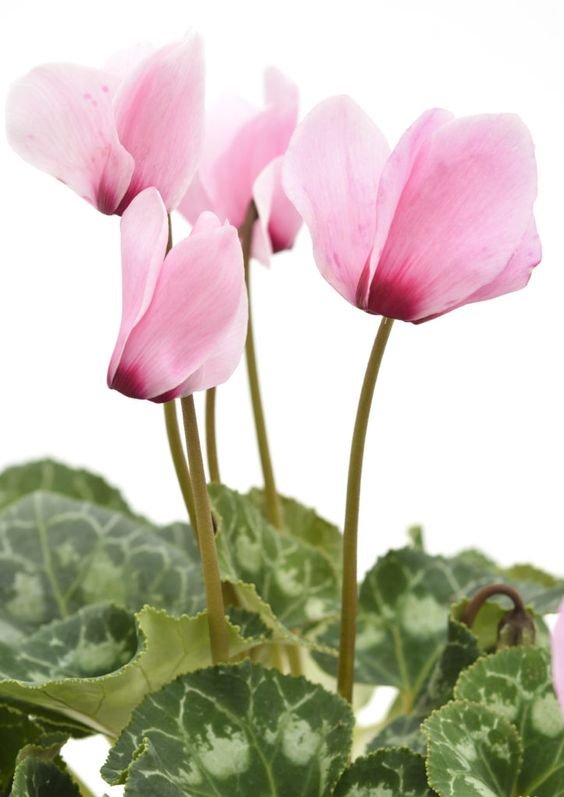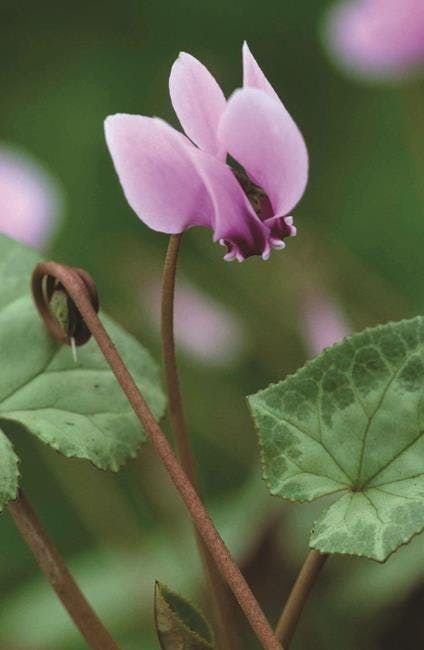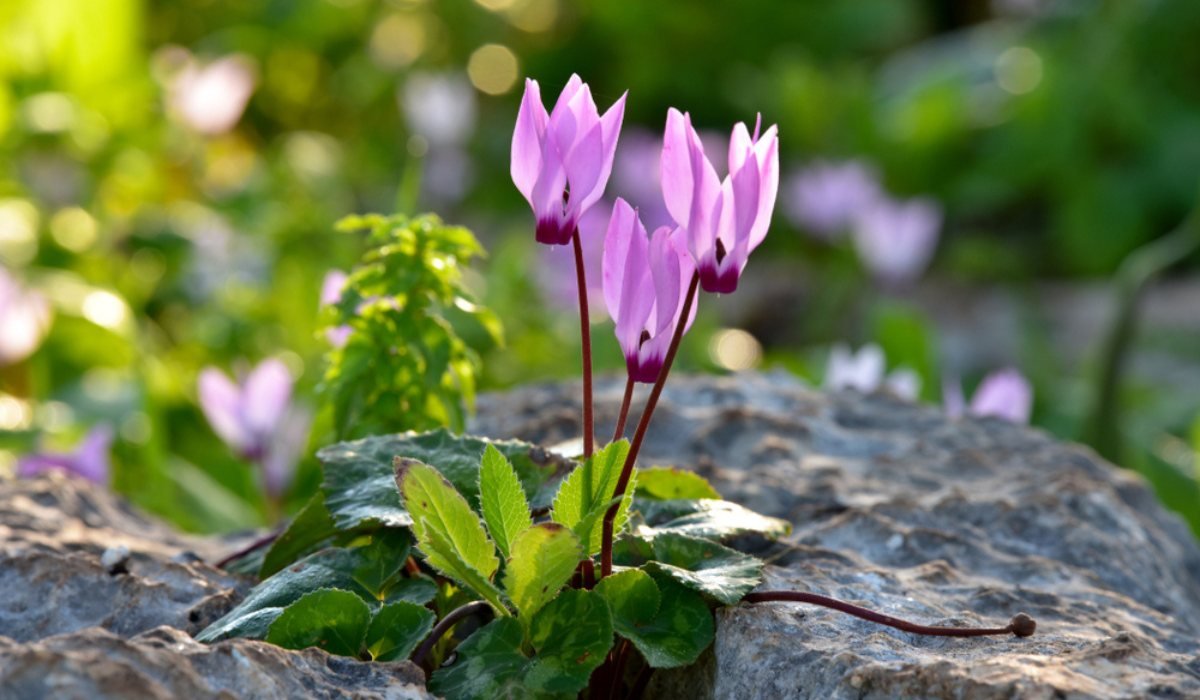Cyclamen is a blooming plant that is very modest and has sweet-smelling, tiny blossoms that are carried on long stalks that rise out above the leaves. It is often cultivated as a houseplant and is especially popular during the winter holiday season, when cyclamen may be found blooming on shelves in garden centres and grocery shops.
It is also commonly planted as a potted plant outside and is known as Alpine Violet, Persian Violet, and Sowbread. Planting seeds in the late summer will result in flowers blooming in the winter of the following year. Cyclamen is a poisonous plant that may be harmful to both people and animals.
Table of Contents
Cyclamen: Key facts
| Genus | Cyclamen |
| Family | Primulaceae |
| Maximum Height | 9 inches |
| Native area | Mediterranean |
| Soil pH | around 6 |
| Season | Winter |
| Sun Exposure | Partial |
Cyclamen: Features
It is a tuberous perennial, which means that during its period of hibernation in the summer, it dies back to its thick roots and then begins to rapidly develop again in the fall. Flowers may be found in a variety of colours, including pink, purple, red, and white. The leaves, which are shaped like hearts, are a medium green colour and frequently include silver marbling.
Cyclamen: Types
Many varieties of cyclamen exist. Because they bloom for so long, you can choose your plant while the flowers are open. Popular types:
- The plants, which are part of the Sierra series, produce enormous blooms that range in colour from white to pink to salmon to red to violet to purple.
- Scentsation is the name given to the blooms of a particular kind which have a powerful aroma and bloom in shades of pink and red.
- Victoria is the name of the variety that has blooms that are ruffled white with red accents.

Source: Pinterest
Cyclamen: Growing tips
- As a result of this plant’s adaptation to the Mediterranean environment, it begins its development cycle in the fall, produces blooms throughout the winter or early spring, and then lies dormant for the whole summer.
- Cyclamen plants dislike high temperatures, draughts, and dry air. They thrive in a climate that mimics their natural habitat, favouring nighttime temperatures between 40 and 50 degrees Fahrenheit and daytime temperatures between 60 and 70 degrees Fahrenheit.
- However, modern hybrids may be maintained throughout a larger temperature range after purchase while still delivering adequate performance.
When to plant Cyclamen?
Autumn season is the best season to plant Cyclamen. Autumn helps the Cyclamen to grow better as a plant and thrive very nicely in the pot. Many gardening experts also plant tubers in autumn for them to be plants in the following year. Note that Cyclamen don’t grow well in the summer heat and the plant may simply wilt.
Where to grow Cyclamen
Cyclamen is most successful when grown in soil that is somewhat acidic, contains a lot of organic matter, and has good drainage. You may use standard potting mix for plants that are kept in containers, but you should also add some sphagnum peat to the soil so that it has a higher acidity.
How to grow Cyclamen
- Remove any wasted blossoms from the plant by twisting the stem and then tugging it firmly to remove it cleanly from the base. This will encourage the plant to continue producing flowers.
- After the petals have faded, seed pods grow.
- These seeds should be harvested, split open, and planted in a tiny container using potting mix mixed with compost.
- Softly cover the seeds with compost or potting soil and lightly wet them.
- Place the pots in a cool, dark location for one to two months, or until the seeds sprout.
- The presence of leaves on a plant indicates that it is making progress toward maturity. Throughout this time, the soil should be watered anytime it has a dry feeling approximately an inch below the surface.
- It is important to keep water from getting on the leaves or the crown of the plant since this might cause the plant to decay.
- Water the plant sparingly but enough throughout the dormant period so as to avoid the soil from completely drying up.
- When the cyclamen plant is in full leaf, use a diluted, low-nitrogen liquid fertiliser every two weeks.
How to propagate Cyclamen
To propagate Cyclamen, use the swollen underground root which is known as the tuber. Lift the tuber from the soil, divide and plant. It is ideal to store cyclamen in a cool, dark location that has enough air circulation throughout the summer when the plant is in its dormant state.
Cyclamen care
- In order to maintain their flowering, these plants require both high humidity and wet soil.
- The plant’s leaves should always be rigid and stand straight up; if you see that it is wilting or falling over, it is likely that it needs some additional moisture. Yellow leaves will appear on plants that are either kept in an excessively damp or dry environment.
- Place the plant container on a tray of damp gravel to increase the relative humidity around the plants and shield them from draughts of heated air.
- Fertiliser is necessary for the growth of cyclamens, but an excess of it will result in lush growth that is more prone to disease. When flowering plants are actively growing, fertilise them every two weeks with a houseplant food or fertiliser that is low in nitrogen. It is unnecessary to fertilise cyclamen when it is dormant.
- During the winter months, when the plant is actively developing, cyclamen benefit from strong light that is indirect.
When do cyclamen flower?
Cyclamen flower in the fall, winter and spring season when the temperature is cool and damp. During summers, the plant’s foliage turns to yellow and the plant’s growth becomes dormant. Whatever energy they get, they store them in their round tubers which will be used in the next flowering season.
Cyclamen: Ornamental uses
- Even the plant’s foliage is beautiful, featuring patterned dark green leaves that are either heart-shaped or spherical in general form.
Cyclamen: Medicinal uses
Cyclamen, in addition to being a vibrant addition to gardens, has a long history of use as a herbal remedy in traditional medicine to treat a wide range of diseases.
- An initial study indicates that taking a cyclamen-containing nasal spray daily for 15 days may reduce sinusitis-related facial discomfort. However, it does not appear to alleviate other symptoms.
- It can be used to alleviate digestion problems and menstrual disorders
However, to assess the effectiveness of cyclamen for various uses, more research is necessary.

Source: Pinterest
FAQs
Is Cyclamen an indoor or outdoor plant?
Florist's cyclamen is a fragile houseplant. In milder climates, cyclamen may be planted outdoors.
Do Cyclamen prefer sun or shade?
Cyclamen prefers full sun.
Is Cyclamen toxic?
Cyclamen contains toxic saponins which might lead to cardiac arrest, seizure, or death when ingested in large quantities. Saponins are also toxic to dogs and cats.
